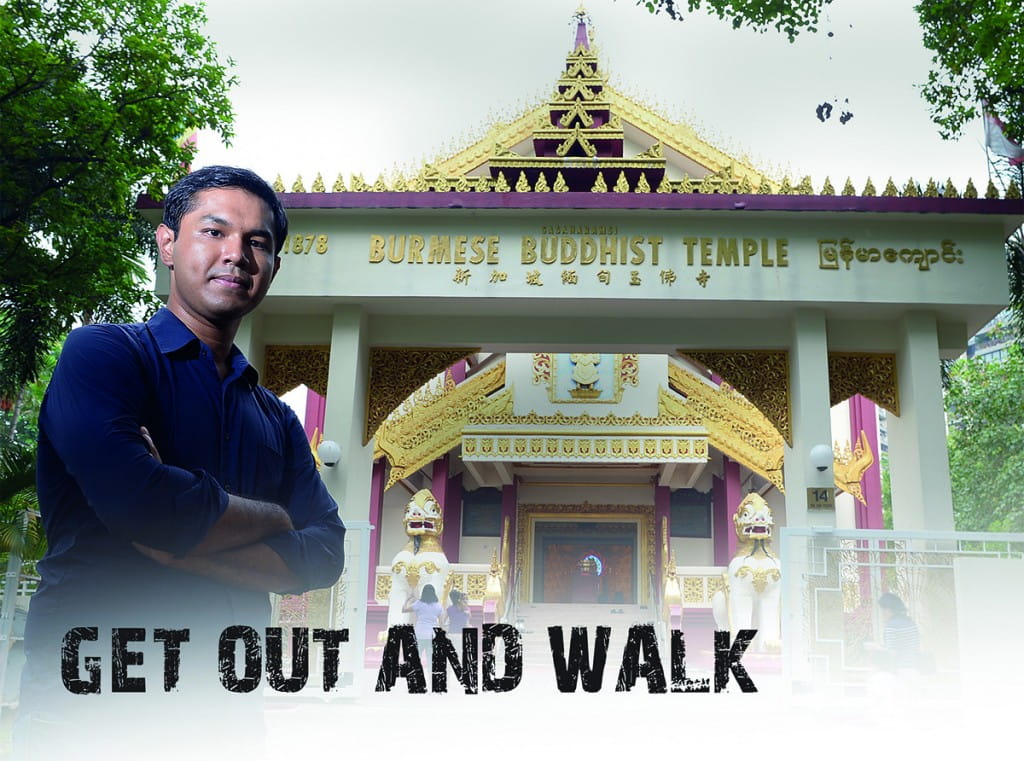
Yan Naung Oak leads tours around Singapore streets with a Myanmar heritage, such as Rangoon, Irrawaddy and Moulmein roads, with his journalist wife, Corrie Tan. Yan teaches at Insworld Institute, a private school in Singapore.
One way to get to know a city on a more personal level is by exploring it on foot — something best done with a group of people from all walks of life who can offer their unique perspectives to create a deeper appreciation of the city’s character.
By Andrea Azureene Heng
t may seem strange that non-Singaporeans are leading walking tours around Singapore. However, a foreigner’s interpretation of what they see and hear during the tour can help locals gain a greater understanding of the city.
Four non-Singaporeans of different nationalities — Bianca Polak is Dutch; Isabel Servando and Mai Tatoy are Filipinas; and Yan Naung Oak is from Myanmar — are part of the Singapore edition of Jane’s Walk that started in 2013. They conduct walking tours that connect both tourists and Singaporeans to their urban environments, helping them rediscover Singapore’s history and identity via the city’s streets.
Polak, Servando and Yan are Walk Leaders with insider knowledge of Singapore that even locals may not have. Proud members of their own local community, they are passionate about Singapore; they appreciate the city’s architectural heritage and also advocate keeping history intact in the face of modernisation.
“Walk Leaders are volunteers who help participants gain a deeper understanding and awareness of what makes and keeps the city vibrant,” explains Tatoy, the City Organiser of the Singapore edition of Jane’s Walk.
SETTING YOU ON THE RIGHT TRAIL
Mai Tatoy, City Organiser
“Doing Jane’s Walk is like paying homage to Singapore. I want people to fall in love with the city I’ve called home for over 23 years,” says Tatoy. A year after the inception of Jane’s Walk in Singapore, Tatoy volunteered to organise her first Singapore walk in 2014.
Being a City Organiser involves planning the walks and recruiting Walk Leaders — volunteers range from professional tour guides and community residents to heritage enthusiasts — via word-of-mouth.
“Many Singaporeans want to learn and discover Singapore for themselves. After all, Jane’s concept is about knowing and appreciating the history of the neighbourhood you live in,” explains Tatoy.
Tatoy says of recruiting walk leaders: “The first batch of walk leaders from 2013 came back to participate in 2014, so that was a huge encouragement. Some walk participants again expressed interest in becoming walk leaders
in 2015.”
Despite not leading the tours herself, Tatoy’s role as City Organiser has been just as fruitful.
“I am heartened by the feedback from participants when they discover something about Singapore that has escaped them before. I sense a deeper appreciation and a better understanding of what makes Singapore unique,” says Tatoy.
She recalls how a 74-year-old and a seven-year-old shared their experiences and views of Singapore on a tour. “It’s a joy to discuss our city in a way that connects the generations, especially when I see the fascination on participants’ faces as they discover a different perspective of the city.”
For 2015, Tatoy is planning themed walks that include Art Deco architecture, black-and-white houses and a dog-friendly walk. “I can only see the walks getting bigger,” she quips.
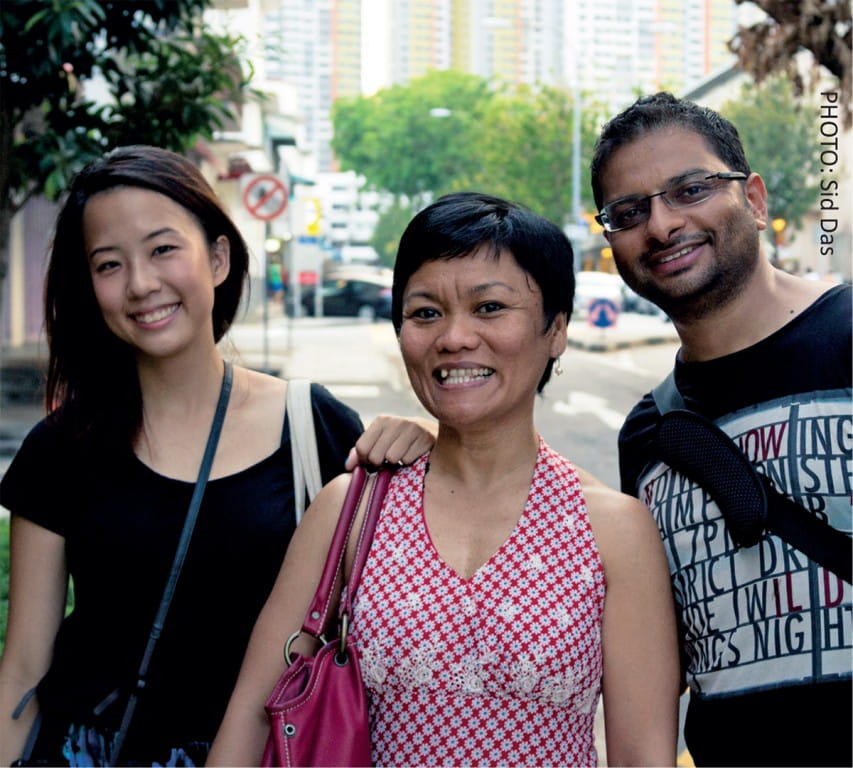
Mai Tatoy (centre) with her volunteers Yvette Tay (left), who did the registration for the 2014 Singapore Jane’s Walk, and Sid Das (right), who was the photographer.
“Many migrant workers from Myanmar rarely get a chance to meet Singaporeans beyond their workplace, so it is a great opportunity for them to get to know locals. Likewise, Singaporeans may not interact with Myanmar people often.”
— Myanmar national Yan Naung Oak, Walk Leader
UNCOVERING HISTORICAL PARALLELS
Yan Naung Oak, Walk Leader
In the south of Myanmar, facing the Andaman Sea, lies a bustling trading city called Mawlamyine that is mentioned in one of Rudyard Kipling’s poems. Moulmein Road in Singapore is a busy street steeped in history, especially with the legacy-rich Tan Tock Seng Hospital being located there.
Spotted the connection between the two places? If not, then you might want to register for a walking tour with Yan Naung Oak. A Myanmar national who has been working and studying in Singapore for more than 10 years, Yan conducts walking tours, under Jane’s Walk, on Myanmar-related landmarks such as Moulmein Road, a Singapore road with Myanmar origins.
He says: “I want to let more Singaporeans know about these roads as well as to satisfy my own curiosity about the origins of their names.”
Yan also conducts ad-hoc tours in his personal time, where he takes Singaporeans to Peninsula Plaza, which is popular with the Myanmar community here. Besides enlightening Singaporeans about the Myanmar people, his tours also give his fellow countrymen opportunities to interact with Singaporeans to help them integrate into Singapore society more easily.
“Many migrant workers from Myanmar rarely get a chance to meet Singaporeans beyond their workplace, so it is a great opportunity for them to get to know locals. Likewise, Singaporeans may not interact with Myanmar people often. I want to foster more exchanges between Singaporeans and the Myanmar community in Singapore.”
Yan’s stint as a tour guide started when his friend asked him to guide some Singaporeans around Peninsula Plaza because many locals were unaware of the Myanmar community there, he recalls. He enjoyed it so much that he decided to continue the tours.
“I enjoy taking Singaporeans to places that have a connection with Myanmar, past and present, such as Moulmein Road. For foreigners, I love to share with them a side of Singapore that cherishes history through its streets,”
he says.
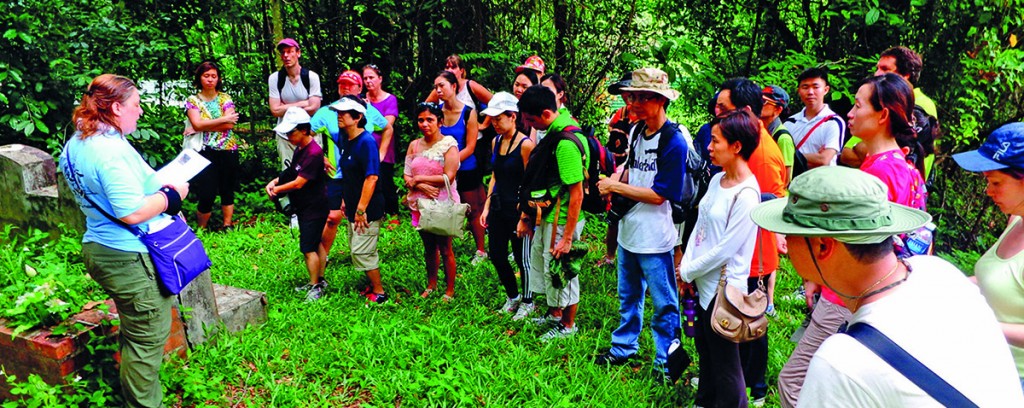
Biana Polak (far left) briefing participants of the Bukit Brown tour on the history of Singapore’s migrant pioneers and their tombs.
HISTORICAL GRAVEYARD
Bianca Polak, Walk Leader
Bianca Polak from the Netherlands is such an expert on Bukit Brown cemetery, located in central Singapore, that she has been leading two- to four-hour walking tours there in the past two years, including those she conducted for Jane’s Walk. The Chinese cemetery is noted for the cultural and historical significance of its tombs.
“I first went to Bukit Brown cemetery in February 2012 on a guided tour conducted by the ‘Brownies’ (a reference to Bukit Brown tour guides). I was blown away by the nature, the huge collection of graves and the peace,” she says.
Polak became such a long-time tour participant that she could not turn down the chance when she was asked to co-guide the walks by “All Things Bukit Brown”, a community co-founded by Claire Leow and Catherine Lim, that promotes awareness of the site.
Polak says she learnt more about Singapore’s history during her walking tours than the numerous visits to local museums in her 15 years here. She found out about Singapore’s pioneers, their tombs and how Singapore got its identity from the migrants who landed here in the late 1800s.
She adds: “What’s interesting is that Bukit Brown cemetery is of Chinese origins but the design hints of Peranakan influences, and there are remnants of Malay kampungs and statues of Sikh guards.”
Last year, Polak jointly guided a tour of Bukit Brown with Leow under Jane’s Walk. She recalls: “At the end of the tour, we asked participants if they wanted to see one more tomb. We were pleasantly surprised when they said ‘yes’. The participants were very enthusiastic.
“As a guide, I love the interaction with the participants. I also enjoy coming up with new ideas. Themed tours are interesting to put together.”
“What’s interesting is that Bukit Brown cemetery is of Chinese origins but the design hints of Peranakan influences, and there are remnants of Malay kampungs and statues of Sikh guards.”
— Dutch Bianca Polak, Walk Leader
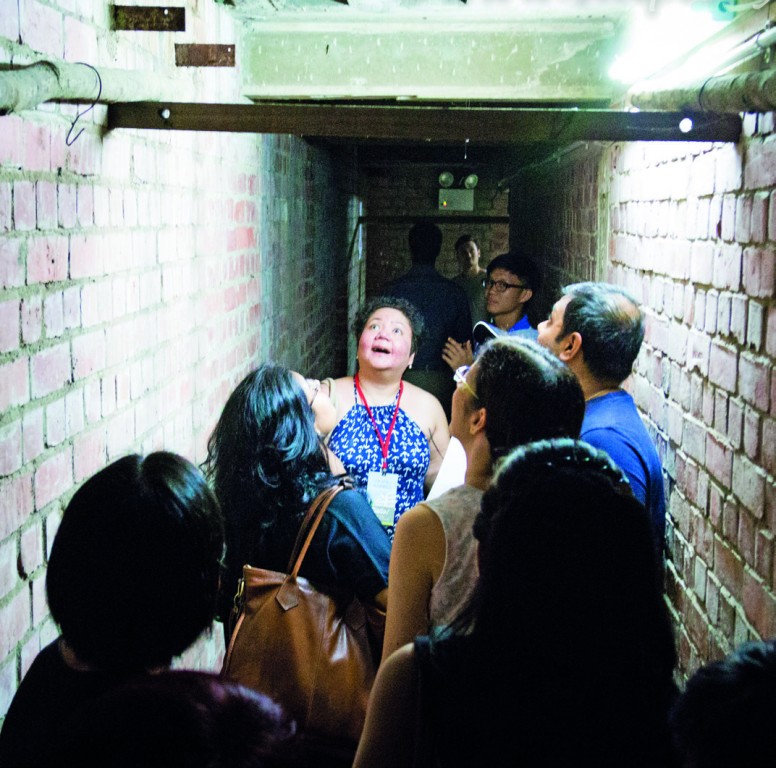
Servando (in blue dress) pointing out the trapdoor in the underground air aid shelter, located just above the heads of participants. It has since been sealed in.
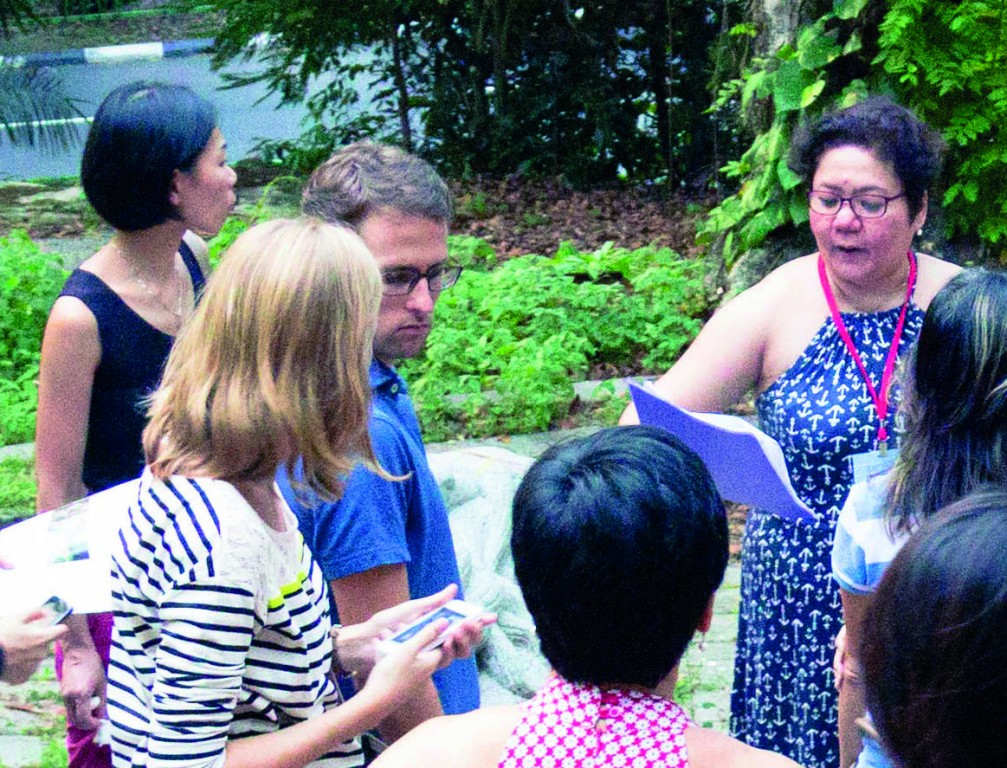
Isabel Servando (far right) briefing tour participants on the history of Tiong Bahru’s architecture.
TALES OF TIONG BAHRU YET UNTOLD
Isabel Servando, Walk Leader
Tiong Bahru residential estate may be becoming a hip enclave, but hidden beyond its indie vibe are historical monuments, such as an air raid shelter dating back to World War II tucked underneath a pre-war building on Guan Chuan Street. Nuggets of such information about Singapore’s oldest estate are revealed on walking tours with Filipina Isabel Servando.
Servando, who has lived in Tiong Bahru for seven out of her eight years in Singapore, has been conducting two- to three-hour walking tours in the estate for the last two years, covering the history of its buildings, some of which date back to before the Japanese Occupation (1942-1945). She has also conducted Tiong Bahru tours under the banner of Jane’s Walk.
Her involvement with walking tours started in April 2013, when Singapore’s National Heritage Board established the Tiong Bahru Heritage Trail, which marked out significant neighbourhood landmarks such as Tiong Bahru Market. Kelvin Ang, Chairman of the Seng Poh Residents’ Committee — a group that organises activities to promote neighbourliness in Tiong Bahru — invited residents to join as tour leaders. “I have always loved showing friends around the neighbourhood, so it seemed natural to try out,” says Servando.
She says there is much to uncover about the estate. “The buildings here speak so much about their past. For example, the back doors of the shophouses here are said to have been used by taipans or rich Chinese as discreet exits after visiting their mistresses — these places then came to be known as the ‘Den of Beauties’.”
As a Walk Leader, Servando has gained many insights: “On first impression, Singaporeans might appear very modern, but I notice Tiong Bahru residents do value the past, like when they share stories of previous occupants of certain shops in the estate.”
She adds: “I love being able to capture people’s interest, seeing them amused or engaged by the stories I tell.”
“On first impression, Singaporeans might appear very modern, but I notice Tiong Bahru residents do value the past, like when they share stories of previous occupants of certain shops in the estate.”
— Filipina Isabel Servando, Walk Leader
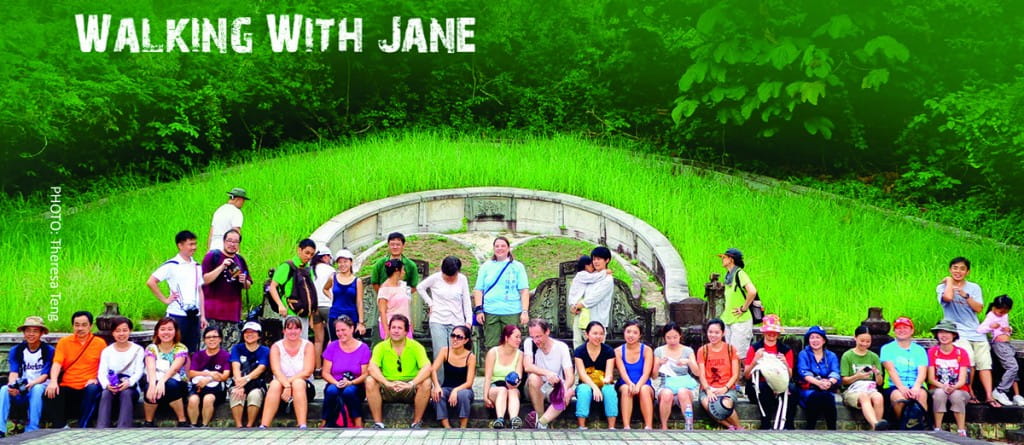
Participants of Bukit Brown tours get a snippet of Singapore’s heritage.
WALKING WITH JANE
Jane’s Walk is an annual walk founded in Toronto in 2007 to honour American-Canadian urban design activist Jane Jacobs (1916-2006), who believed that walking is one of the best ways to know a city. She felt that it was important for residents of a neighbourhood to give their input on how it develops.
The free walking tours are not necessarily about landmarks. They are also platforms through which participants discuss a community’s social issues, urban planning concerns and local culture.
Walks are led by volunteers and held on the first weekend of May — close to Jacobs’ birthday.
Jane’s Walks are currently held in more than 100 cities around the world. For the Singapore edition, visit : www.janeswalk.org/singapore/singapore
